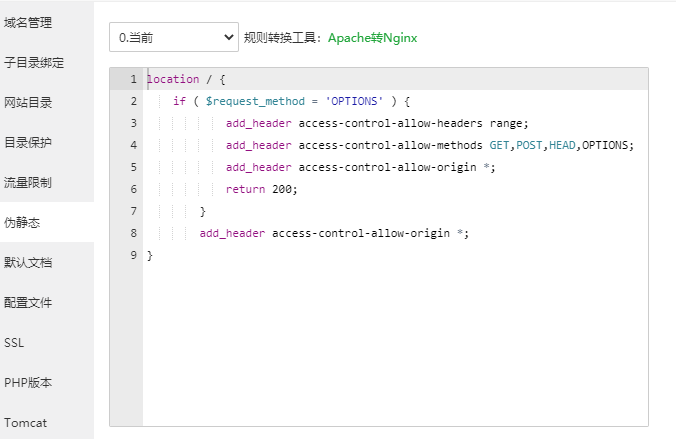nginx可以为网站或目录甚至特定的文件设置密码认证。密码必须是crypt加密的。可以用apache的htpasswd来创建密码。
格式为:
htpasswd -b -c site_pass username password
site_pass为密码文件。放在同nginx配置文件同一目录下,当然你也可以放在其它目录下,那在nginx的配置文件中就要写明绝对地址或相对当前目录的地址。
如果你输入htpasswd命令提示没有找到命令时,你需要安装httpd。如果是centos可以执行如下来安装,
yum install httpd
如果你不想安装httpd的话,可以使用perl脚本来实现(代码如下:)
#! /usr/bin/perl -w #filename: add_ftp_user.pl use strict; # print "#example: user:passwdn"; while (<STDIN>) { exit if ($_ =~/^n/); chomp; (my $user, my $pass) = split /:/, $_, 2; my $crypt = crypt $pass, '$1$' . gensalt(8); print "$user:$cryptn"; } sub gensalt { my $count = shift; my @salt = ('.', '/', 0 .. 9, 'A' .. 'Z', 'a' .. 'z'); my $s; $s .= $salt[rand @salt] for (1 .. $count); return $s; }
chmod o+x add_user.pl
脚本使用方法:
./add_user.pl user:password
把生成的用户名密码粘贴到/usr/local/nginx/conf/vhost/nginx_passwd文件中即可
如果是为了给网站加上认证,可以直接将认证语句写在nginx的配置server段中。
如果是为了给目录加上认证,就需要写成目录形式了。同时,还要在目录中加上php的执行,否则php就会被下载而不执行了。
例如:基于整个网站的认证,auth_basic在php解释之前。
server { listen 80; server_name www.jb51.net jb51.net; root /www/jb51.net; index index.html index.htm index.php; auth_basic "input you user name and password"; auth_basic_user_file /usr/local/nginx/conf/vhost/nginx_passwd; location ~ .php$ { fastcgi_pass 127.0.0.1:9000; fastcgi_index index.php; include fastcgi_params; } location ~ /.ht { deny all; } access_log /logs/jb51.net_access.log main; }
针对目录的认证,在一个单独的location中,并且在该location中嵌套一个解释php的location,否则php文件不会执行并且会被下载。auth_basic在嵌套的location之后。
server { listen 80; server_name www.jb51.net jb51.net; root /www/jb51.net; index index.html index.htm index.php; location ~ ^/admin/.* { location ~ .php$ { fastcgi_pass 127.0.0.1:9000; fastcgi_index index.php; include fastcgi_params; } auth_basic "auth"; auth_basic_user_file /usr/local/nginx/conf/vhost/auth/admin.pass; } location ~ .php$ { fastcgi_pass 127.0.0.1:9000; fastcgi_index index.php; include fastcgi_params; } location ~ /.ht { deny all; } access_log /logs/jb51.net_access.log main; }
这里有一个细节,就是location ~ ^/admin/.* {…} 保护admin目录下的所有文件。如果你只设了/admin/ 那么直接输入/admin/index.php还是可以访问并且运行的。 ^/admin/.* 意为保护该目录下所有文件。当然,只需要一次认证。并不会每次请求或每请求一个文件都要认证一下。
htpasswd
既然是使用到了htpasswd,那么就顺带着介绍一下其基本使用。
htpasswd参数
-c 创建passwdfile.如果passwdfile 已经存在,那么它会重新写入并删去原有内容.
-n 不更新passwordfile,直接显示密码
-m 使用MD5加密(默认)
-d 使用CRYPT加密(默认)
-p 使用普通文本格式的密码
-s 使用SHA加密
-b 命令行中一并输入用户名和密码而不是根据提示输入密码,可以看见明文,不需要交互
-D 删除指定的用户
实例
1. 如何利用htpasswd命令添加用户?
# /usr/local/apache/bin/htpasswd -bc linuxeye_pd linuxeye_user linuxeye_password Adding password for user linuxeye_user # cat linuxeye_pd linuxeye_user:$apr1$Mugpp3FE$zGsi7/JfQIhFXPlgqo/Wx/
生成当前目录下生成一个linuxeye_pd文件,用户名linuxeye_user,密码:linuxeye_password,默认采用MD5加密方式
2. 如何在原有密码文件中增加下一个用户?
# /usr/local/apache/bin/htpasswd -b linuxeye_pd linuxeye.com linuxeye.com Adding password for user linuxeye.com # cat linuxeye_pd linuxeye_user:$apr1$Mugpp3FE$zGsi7/JfQIhFXPlgqo/Wx/ linuxeye.com:$apr1$/8EUOPYI$4MBxYpzotrSDcTTDZvTeT0
一定要去掉-c选项,否则覆盖密码文件再创建
3. 如何不更新密码文件,只显示加密后的用户名和密码?
# /usr/local/apache/bin/htpasswd -n linuxeye New password: Re-type new password: linuxeye:$apr1$bZ6Gclc4$zKRap.0BADzZIxLoxpDNv0 # /usr/local/apache/bin/htpasswd -nb linuxeye linuxeye_password linuxeye:$apr1$yvngdKGV$QrnlriJ.MxIu52Vmo.ROE1
4. 如何利用htpasswd命令删除用户名和密码?
# /usr/local/apache/bin/htpasswd -D linuxeye_pd linuxeye_user Deleting password for user linuxeye_user # cat linuxeye_pd linuxeye.com:$apr1$/8EUOPYI$4MBxYpzotrSDcTTDZvTeT0
5. 如何利用htpasswd命令修改密码?
# /usr/local/apache/bin/htpasswd -D linuxeye_pd linuxeye.com Deleting password for user linuxeye.com # /usr/local/apache/bin/htpasswd -b linuxeye_pd linuxeye.com linuxeye_passwd Adding password for user linuxeye.com # cat linuxeye_pd linuxeye.com:$apr1$74ZvB1vC$/b7ETmg8xhDPieYj0b0cE.















暂无评论内容